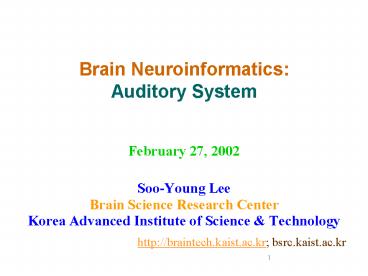Brain Neuroinformatics: Auditory System PowerPoint PPT Presentation
1 / 29
Title: Brain Neuroinformatics: Auditory System
1
Brain NeuroinformaticsAuditory System
- February 27, 2002
- Soo-Young Lee
- Brain Science Research Center
- Korea Advanced Institute of Science Technology
- http//braintech.kaist.ac.kr bsrc.kaist.ac.kr
2
Artificial Auditory System
- Based on Human Cognitive Mechanism
- Develop mathematical model and auditory chip
- Develop Continuous speech recognition system
3
Auditory Pathway
- ? Improvement of Cochlea model
- Binaural hearing model
- Auditory cortex model
- Selective attention model
- Continuous-speech recognition system
- Speech-recognition chip
4
Research Scopes
Auditory Pathway
5
Masking
- Lateral Inhibition
- Recursive
6
Masking using Lateral Inhibition
7
Temporal Masking
8
Temporal Masking Integration Model
9
Time Frequency Response
10
Isolated Word Recognition Rates
11
Discussions Masking
- Masking Suppresses Unwanted Noisy Components in
Signal - Simultaneous Masking by Lateral Inhibition
- - Recognition performance was enhanced with
MFCC model - - Proposed model can be used with any
auditory model - - ZCPA has spectral masking effect
- Temporal Masking by Unilateral Inhibition
- - Unilateral inhibition using the integration
model - - Model resembles other feature processing
algorithms - - Recognition performance was enhanced with
RASTA parameters
12
Channel Compensation
- ASR in mismatched environments
- Environmental information
- Background noise, acoustic/transmission channel
- Assume environment degradation model
13
Speaker-to-Microphone mapping
- Mapper train
- Where and which type of mapper should be
deployed?
14
Adaptive Noise Cancelling
- Adaptive noise cancelling
- An approach to reduce noise based on reference
noise signals - System output
- The LMS algorithm
15
ICA-based Approach to ANC
- The difference between the LMS algorithm and the
ICA-based approach - Existence of the score function
- The LMS algorithm
- Decorrelate output signal from the reference
input - The ICA-based approach
- Make output signal independent of the reference
input - Independence
- Involve higher-order statistics including
correlation - The ICA-based approach
- Remove the noise components using higher-order
statistics and correlation
16
TDAF approach to ANC
- Normalized LMS algorithm
- Normalized ICA-based algorithm
where
where
17
Experimental Results (1)
- Experiments for artificially generated i.i.d.
signals - SNRs of output signals for the simple simulation
mixing filter (dB)
Signal and Noise Initial SNRs SNRs after convergence SNRs after convergence SNRs after convergence
Signal and Noise Initial SNRs LMS algorithm ICA-based approach ICA-based approach
Signal and Noise Initial SNRs LMS algorithm
Laplacian -3.0 30.9 38.0 31.3
Laplacian 10.0 30.9 38.3 31.7
Gaussian -3.0 30.6 28.7 30.3
Gaussian 10.0 30.6 28.7 30.0
18
Experimental Results (2)
- Experiments for recorded signals
- Signal waveforms for the car noise and the simple
simulation filter
Signal source
Noise source
Primary input signal
System output signal
19
Experimental Results (3)
- Experiments for recorded signals
- SNRs of output signals for the measured filter
20
Experimental Results (4)
- Comparison of learning curves with and without
TDAF - Car noise
The ICA-based approach
The LMS algorithm
21
Discussion ANC
- A method to ANC based on ICA was proposed.
- The ICA-based learning rule was derived.
- The ICA-based approach
- Include higher-order statistics
- Make the output independent of the reference
input - The LMS algorithm
- Make the output uncorrelated to the reference
input - Gave better performances than the LMS algorithm
- TDAF method was applied to the ICA-based
approach. - Derived the normalized ICA-based learning rule
- Improved convergence rates
22
Bottom-Up and Top-Down Attention
External Cue
Internal Cue
Attended Output
Classifier Output
- Bottom-Up
- - Masking
- - ICA
- Top-Down
- - MLP
- - HMM
Bottom-Up Recognition
Top-Down Expectation
Attended Input
Bottom-Up Attention
Input Features
Brain
Environment
Input Stimulus
23
??? ?? ?? ????(1)
- ??? ?? ?? ????
- ??8051???? ??(???)
- 12 MHz ?? 1.93 MIPS
- ???? ?? ??(16??)
- ?? ??? ?? ?? ???
- 50 ?? ? 20 ms ?? ?? ?? ??
- ??? 95 ??
24
??? ?? ?? ????(2)
- Hynix 0.35 ??
- ??? ?? 64-TQFP
- ?? ??? 128x12, 256x8, 2048x8
- AGC, A/D, D/A ??
- 12KHz, 12 bit A/D
- 12Khz, 8 bit D/A
- ??? ?? ?? ????
- ?? ?? ????
- ?? ?? ????
- ??? ?? ???? ??
25
??? ?? ?? ????(3)
- CM8051 ??? ? I/O ???
26
??? ?? ?? ????(4)
- ?? ?? ???
27
Analogue ICA Chip
- ? ? multiplier
- ? ? current summation
- r ? learning rate
4 x 4 ICA network in one Chip
28
Test Results in Waveforms
- Source Signals (s1, s2)
- two different males voice
- 16 kHz sampled
- Mixed Signals (x1, x2)
- Instantaneous mixture
- Mixing Mtx A is
- Separated Signals (o1, o2)
- Recovered original sources
29
Fabricated Chip
- 2.8mm x 2.8mm
- AMS CMOS 0.6um
- 2 poly-3 metal
- Analog Digital Hybrid Process
Die Photo of a Fabricated ICA Chip

